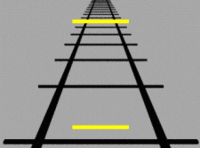
Photo from wikipedia
Previous research has demonstrated a functional dissociation between vision for perception and vision for action. However, the developmental trajectory of this functional dissociation is not well understood. We directly compared… Click to show full abstract
Previous research has demonstrated a functional dissociation between vision for perception and vision for action. However, the developmental trajectory of this functional dissociation is not well understood. We directly compared the sensitivity of grasping and perceptual estimations within the same experimental design to the real and illusory sizes of objects positioned in the Ponzo illusion display. Two different-sized objects were placed such that the differences between their real sizes and their perceived sizes were pitted against each other. Children aged 5-8 years and adults made perceptual size discriminations and then grasped (action) or estimated (perception) one of the objects based on its perceived size. Consistent with previous results, for the action task, grasping apertures of adults were scaled with the physical differences in the objects' sizes, even in trials where their overt perceptual decisions were deceived by the illusion. In contrast, perceptual estimations were robustly modulated by the illusion. Interestingly, children outperformed adults in their perceptual discriminations but exhibited adult-like behavior in grasping and in perceptual estimations of the objects, demonstrating a dissociation between perception and action. These results suggest that although the two visual functions are not operating at fully mature levels during childhood, some key mechanisms that support a dissociation between these functions are already in place.
Journal Title: Journal of experimental child psychology
Year Published: 2020
Link to full text (if available)
Share on Social Media: Sign Up to like & get
recommendations!